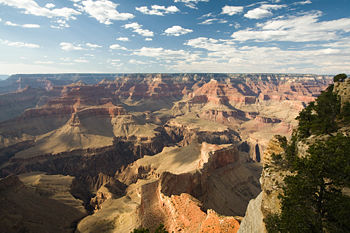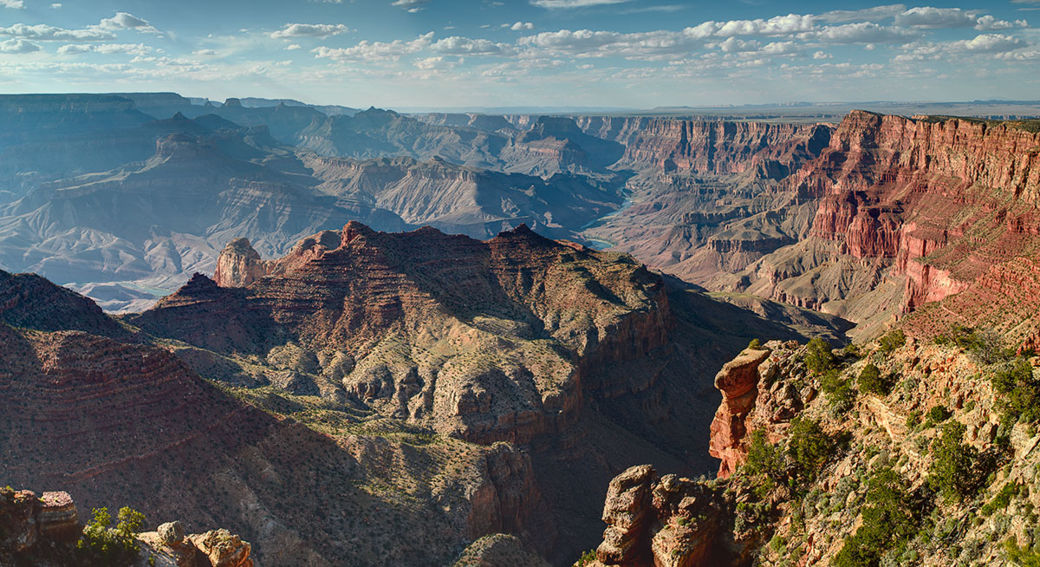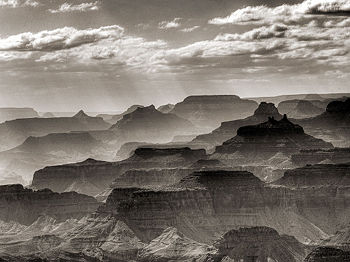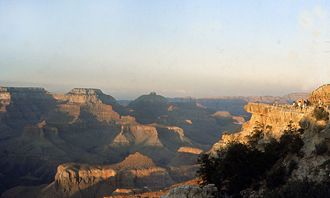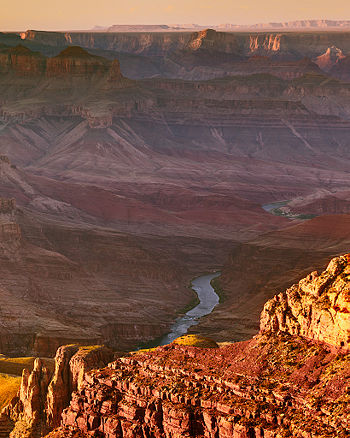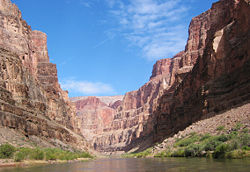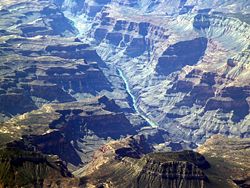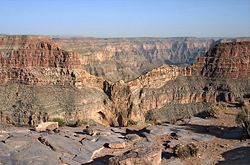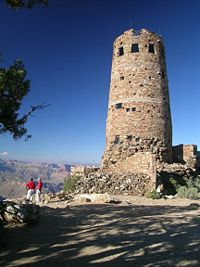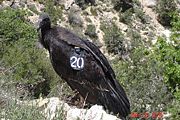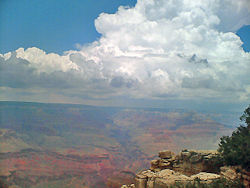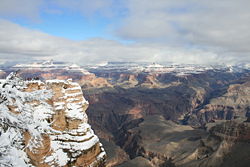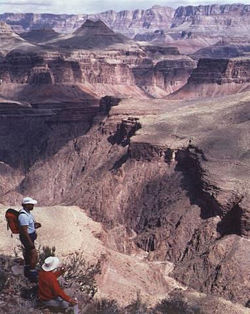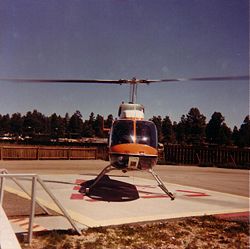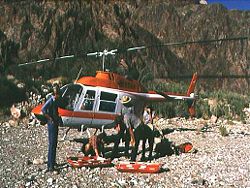Grand Canyon
2008/9 Schools Wikipedia Selection. Related subjects: North American Geography
The Grand Canyon is a steep-sided gorge carved by the Colorado River in the U.S. state of Arizona,and parts of Nevada. It is largely contained within the Grand Canyon National Park — one of the first national parks in the United States. President Theodore Roosevelt was a major proponent of preservation of the Grand Canyon area, and visited on numerous occasions to hunt and enjoy the scenery.
Longstanding scientific consensus has been that the canyon was created by the Colorado River over a period of six million years, but research released in 2008 suggests a much longer 17 million year time span. The canyon is 277 miles (446 km) long, ranges in width from 4 to 18 miles (6.4 to 29 km) and attains a depth of more than a mile (1.6 km). Nearly two billion years of the Earth's history have been exposed as the Colorado River and its tributaries cut their channels through layer after layer of rock while the Colorado Plateau was uplifted. The "canyon started from the west, then another formed from the east, and the two broke through and met as a single majestic rent in the earth some six million years ago. [...] The merger apparently occurred where the river today, coming from the north, bends to the west, in the area known as the Kaibab Arch."
During prehistory, the area was inhabited by Native Americans who built settlements within the canyon and its many caves. The Pueblo people considered the Grand Canyon ("Ongtupqa" in Hopi language) a holy site and made pilgrimages to it. The first European known to have viewed the Grand Canyon was García López de Cárdenas from Spain, who arrived in 1540. In 1869, Major John Wesley Powell, a one-armed Civil War veteran with a thirst for science and adventure, made the first recorded journey through the canyon on the Colorado River. Powell referred to the sedimentary rock units exposed in the canyon as "leaves in a great story book".
Geography
The Grand Canyon is a massive rift in the Colorado Plateau that exposes uplifted Proterozoic and Paleozoic strata and is also one of the six distinct physiographic sections of the Colorado Plateau province. The Grand Canyon is unmatched throughout the world for the vistas it offers to visitors on the rim. It is not the deepest canyon in the world — Cotahuasi Canyon (11598 feet or 3535 m) and Colca Canyon (10499 feet or 3200 m), both in Arequipa, Peru, and Hell's Canyon (7,993 feet or2436 m) on the Oregon-Idaho border, are all deeper — but Grand Canyon is known for its overwhelming size and its intricate and colorful landscape. Geologically it is significant because of the thick sequence of ancient rocks that are beautifully preserved and exposed in the walls of the canyon. These rock layers record much of the early geologic history of the North American continent.
Uplift associated with mountain building events later moved these sediments thousands of feet upward and created the Colorado Plateau. The higher elevation has also resulted in greater precipitation in the Colorado River drainage area, but not enough to change the Grand Canyon area from being semi-arid. The uplift of the Colorado Plateau is uneven, and the north-south trending Kaibab Plateau that Grand Canyon bisects is over a thousand feet higher at the North Rim (about 1,000 ft/300 m) than at the South Rim. The fact that the Colorado River flows in a curve around the higher North Rim part of the Kaibab Plateau and closer to the South Rim part of the plateau is also explained by this asymmetry. Ivo Lucchitta of the U.S. Geological Survey first suggested that, as the Colorado River developed before significant erosion of the region, it naturally found its way across or around the Kaibab Uplift by following a "racetrack" path to the south of the highest part of the plateau. Almost all runoff from the North Rim (which also gets more rain and snow) flows toward the Grand Canyon, while much of the runoff on the plateau behind the South Rim flows away from the canyon (following the general tilt). The result is deeper and longer tributary washes and canyons on the north side and shorter and steeper side canyons on the south side.
Temperatures on the North Rim are generally lower than the South Rim because of the greater elevation (averaging 8,000 ft/2,438 m above sea level). Heavy rains are common on both rims during the summer months. Access to the North Rim via the primary route leading to the canyon ( State Route 67) is limited during the winter season due to road closures. Views from the North Rim tend to give a better impression of the expanse of the canyon than those from the South Rim.
Geology
The principal consensus among geologists is that the Colorado River basin (of which the Grand Canyon is a part) has developed in the past 40 million years. A recent study places the origins of the canyon beginning some 17 million years ago. Previous estimates had placed the age of the canyon at 5 to 6 million years. The study, which was published in 2008 in the journal Science utilized uranium-lead dating to analyze calcite deposits found on the walls of nine caves throughout the canyon. There is a substantial amount of controversy because this research suggests a such substantial departure from prior widely supported scientific consensus.
The result of all this erosion is one of the most complete geologic columns on the planet.
The major geologic exposures in Grand Canyon range in age from the 2 billion year old Vishnu Schist at the bottom of the Inner Gorge to the 230 million year old Kaibab Limestone on the Rim. Interestingly, there is a gap of about one billion years between the stratum that is about 500 million years old and the lower level, which is about 1.5 billion years old. That indicates a period of erosion between two periods of deposition.
Many of the formations were deposited in warm shallow seas, near-shore environments (such as beaches), and swamps as the seashore repeatedly advanced and retreated over the edge of a proto-North America. Major exceptions include the Permian Coconino Sandstone, which most geologists interpret as an aeolian sand dune deposit and several parts of the Supai Group.
The great depth of the Grand Canyon and especially the height of its strata (most of which formed below sea level) can be attributed to 5,000 to 10,000 feet (1500 to 3000 m) of uplift of the Colorado Plateau, starting about 65 million years ago (during the Laramide Orogeny). This uplift has steepened the stream gradient of the Colorado River and its tributaries, which in turn has increased their speed and thus their ability to cut through rock (see the elevation summary of the Colorado River for present conditions).
Weather conditions during the ice ages also increased the amount of water in the Colorado River drainage system. The ancestral Colorado River responded by cutting its channel faster and deeper.
The base level and course of the Colorado River (or its ancestral equivalent) changed 5.3 million years ago when the Gulf of California opened and lowered the river's base level (its lowest point). This increased the rate of erosion and cut nearly all of the Grand Canyon's current depth by 1.2 million years ago. The terraced walls of the canyon were created by differential erosion.
About one million years ago, volcanic activity (mostly near the western canyon area) deposited ash and lava over the area, which at times completely obstructed the river. These volcanic rocks are the youngest in the canyon.
Human history
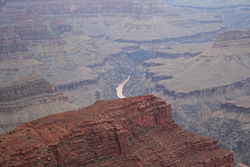
The Ancestral Puebloans (The Ancient Ones, or Anasazi)
- The Basketmakers
- The Pueblo Anasazi
- Ancient Puebloan Occupation of the Grand Canyon
- Nankoweap Canyon
- The Unkar Delta (see Geology of the Grand Canyon area)
- The Bright Angel site
- Ancient Pueblo Peoples leave the Canyon
- Beamer's Cabin
- The Beamers Back Window
- Beamer's Cabin
Other cultures
- The Cohonina
- The Sinagua
- The Pai (The People)
- The Hualapai (The People of the Pine Trees)
- The Havasupai (The People of the blue-green water)
- The Paiutes (The Water People)
- The Dineh (The People)
European arrival and settlement
The Spanish explorers
In September 1540, under orders from the conquistador Francisco Vázquez de Coronado to search for the fabled Seven Cities of Cibola, Captain Garcia Lopez de Cardenas, along with Hopi guides and a small group of Spanish soldiers, traveled to the South Rim of the Grand Canyon between Desert View and Moran Point. Pablo de Melgrossa, Juan Galeras, and a third soldier descended some one third of the way into the Canyon until they were forced to return because of lack of water. In their report, they noted that some of the rocks in the Canyon were "bigger than the great tower of Seville." It is speculated that their Hopi guides must have been reluctant to lead them to the river, since they must have known routes to the canyon floor. Afterwards, no Europeans visited the Canyon for over two hundred years.
Fathers Francisco Atanasio Domínguez and Silvestre Vélez de Escalante were two Spanish Priests who, with a group of Spanish soldiers, explored southern Utah and traveled along the North Rim of the Canyon in Glen and Marble Canyons in search of a route from Santa Fe to California in 1776. They eventually found a crossing at present-day Lees Ferry.
Also in 1776, Fray Francisco Garces, a Franciscan missionary, spent a week near Havasupai, unsuccessfully attempting to convert a band of Indians. He described the Canyon as "profound". Jacob Hamblin (a Mormon missionary) was sent by Brigham Young in the 1850s to locate easy river crossing sites in the Canyon. Building good relations with local Native Americans and white settlers, he discovered Lee's Ferry in 1858 and Pierce Ferry (later operated by, and named for, Harrison Pierce) - the only two sites suitable for ferry operation. He also acted as an advisor to John Wesley Powell before his second expedition to the Grand Canyon, acting as a diplomat between Powell and the local native tribes to ensure the safety of his party.
In 1857 Edward Fitzgerald Beale superintendent of an expedition to survey a wagon road along the 35th parallel from Fort Defiance to the Colorado river led a small party of men in search of water on the Coconino plateau on the south rim of the Grand Canyon. On September 19th near present day National Canyon they came upon what May Humphreys Stacey described in his journal as "...a wonderful canyon four thousand feet deep. Everyone (in the party) admitted that he never before saw anything to match or equal this astonishing natural curiosity."
Also in 1857, the U.S. War Department asked Lieutenant Joseph Ives to lead an expedition to assess the feasibility of an up-river navigation from the Gulf of California. Also in a stern wheeler steamboat "Explorer", after two months and 350 miles (560 km) of difficult navigation, his party reached Black Canyon some two months after George Johnson. The "Explorer" struck a rock and was abandoned. Ives led his party east into the Canyon — they were the first Europeans to travel the Diamond Creek drainage and traveled eastwards along the South Rim.
In 1858, John Strong Newberry became probably the first geologist to visit the Grand Canyon.
- The John Wesley Powell River Expeditions
- The Brown-Stanton River Expedition
- Other expeditions
Settlers in and near the canyon
- Miners: "Captain" John Hance, William W. Bass, Louis Boucher "The Hermit", Seth Tanner, Charles Spencer, D. W. "James" Mooney
- Lees Ferry: John Doyle Lee, Emma Lee (17th of John Lee's 19 wives), J. S. Emmett, Charles Spencer
- Phantom Ranch: David Rust, Mary Colter
- Grand Canyon Village: Ralph H. Cameron
Federal protection
The federal government administrators who manage park resources face many challenges. These include issues related to the recent reintroduction into the wild of the highly endangered California Condor, air tour overflight noise levels, water rights disputes with various tribal reservations that border the park, and forest fire management. The Grand Canyon National Park superintendent is Steve Martin. Martin was named superintendent on February 5, 2007 to replace retiring superintendent Joe Alston. Martin was previously the National Park Service Deputy Director and superintendent of several other national parks including Denali and Grand Teton.
South Rim buildings
There are several historical buildings located along the South Rim; most are in Grand Canyon Village.
Buckey O'Neill Cabin was built during the 1890s by William Owen O'Neill. He built the cabin because of a copper deposit that was nearby. He had several occupations such as miner, judge, politician, author and tour guide. This cabin is the longest continually standing structure in the South Rim. It is currently used as a guest house; booking is required well in advance.
Kolb Studio was built in 1904 by brothers Ellsworth and Emery Kolb. They were photographers who made a living by photographing visitors walking down the Bright Angel Trail. In 1911, the Kolb brothers filmed their journey down the Green and Colorado Rivers. Emery Kolb showed this movie regularly in his studio until 1976, when he died at the age of 95. Today the building serves as an art gallery and exhibit.
The El Tovar Hotel was built in 1905 and is the most luxurious lodging on the South Rim. The hotel consists of 4 stories with a rustic chalet appearance. It was designed by Charles Whittlesley. A gift shop and restaurant are located inside the hotel.
Hopi House was built by Mary Jane Colter in 1905. It is based on structures that were built in an ancient Hopi settlement called Old Oraibi, located on the Third Mesa in eastern Arizona. It served as a residence for the Hopi Indians who sold arts and crafts to visitors in the South Rim.
Verkamp's Curios was built by John Verkamp in 1905. He sold arts and crafts as well as souvenirs. It is currently run by his descendants and stands next to the Hopi House.
Grand Canyon Railway Depot was built in 1909 and contains 2 levels. It is one of only three log-cabin-style train stations currently standing in the United States, of the fourteen ever built in the U.S. The depot is the northern terminus of the Grand Canyon Railway which begins in Williams, Arizona.
Lookout Studio was built in 1914 and is another structure that was designed by Mary Colter. Photography artwork, books, souvenirs, and rock and fossil specimens are sold here. A great view of Bright Angel Trail can be seen here.
Desert View Watchtower was built in 1932 and is one of Mary Colter's best-known works. Situated at the far eastern end of the South Rim, 27 miles (43 km) from Grand Canyon Village, the tower sits on a 7,400 foot (2,256 m) promontory. It offers one of the few views of the bottom of the Canyon and the Colorado River. It is designed to mimic an Anasazi watchtower though it is larger than existing ones.
Bright Angel Lodge was built of logs and stone in 1935. Mary Colter designed the lodge and it was built by Fred Harvey. Inside the lodge is a small museum honoring Fred Harvey, who played a major role in popularizing the Grand Canyon. In the history room is a fireplace that is made of stone from the South Rim that is layered in the same sequence as in the canyon.
Ecosystem
Federal officials started a flood in the Grand Canyon in hopes of restoring its ecosystem on March 5, 2008. The canyon's ecosystem was permanently changed after the construction of the Glen Canyon Dam in 1963.
Weather
Weather in the Grand Canyon varies according to elevation.
The forested rims are high enough to receive winter snowfall, but along the Colorado River in the Inner Gorge, temperatures are similar to those found in Tucson and other low elevation desert locations in Arizona. Conditions in the Grand Canyon region are generally dry, but substantial precipitation occurs twice annually, during seasonal pattern shifts in winter (when Pacific storms usually deliver widespread, moderate rain and high-elevation snow to the region from the west) and in late summer (a phenomenon known as the " monsoon", which delivers waves of moisture from the southeast, causing dramatic, localized thunderstorms fueled by the heat of the day). Average annual precipitation on the South Rim is less than 16 inches (35 cm), with 60 inches (132 cm) of snow, the higher North Rim usually receives 27 inches (59 cm) of moisture, with a typical snowfall of 144 inches (317 cm), and Phantom Ranch, far below the Canyon's rims along the Colorado River at 2,500 feet (762 m) gets just 8 inches (17.6 cm) of rain, and snow is a rarity. The weather is different on the north rim and south rim.
Temperatures vary wildly throughout the year, with summer highs within the Inner Gorge commonly exceeding 100 °F (37.8 °C) and winter minimum temperatures sometimes falling below zero degrees Fahrenheit (-17.8 °C) along the canyon's rims. Visitors are often surprised by these potentially extreme conditions, and this, along with the high altitude of the canyon's rims, can lead to unpleasant side effects such as dehydration, sunburn, and hypothermia. Be prepared for a variety of potential weather conditions when visiting, and keep in mind the Grand Canyon is a rugged natural feature located in a remote area subject to a wide range of environmental hazards.
Weather conditions can greatly affect hiking and canyon exploration, and visitors should obtain accurate forecasts because of hazards posed by exposure to extreme temperatures, winter storms and late summer monsoons. While the park service posts weather information at gates and visitor centers, this is a rough approximation only, and should not be relied upon for trip planning. For accurate weather in the Canyon, hikers should consult the National Weather Service's NOAA weather radio or the official NWS website.
Air pollution
The Grand Canyon has suffered some problems with air pollution, attributed to the nearby Navajo Generating Station, a coal-burning power plant. In 1991 an agreement was reached with the Navajo Generating Station in Page, Arizona to add air pollution control devices to their smokestacks.
Grand Canyon tourism
Grand Canyon National Park is one of the world’s premier natural attractions, attracting about five million visitors per year. Overall, 83% were from the United States: California (12.2%), Arizona (8.9%), Texas (4.8%), Florida (3.4%) and New York (3.2%) represented the top domestic visitors. Seventeen percent of visitors were from outside the United States; the most prominently represented nations were the United Kingdom (3.8%), Canada (3.5%), Japan (2.1%), Germany (1.9%) and The Netherlands (1.2%).
Activities
Aside from casual sightseeing from the South Rim (averaging 7000 feet (2100 metres) above sea level), whitewater rafting, hiking and running are especially popular. The floor of the valley is accessible by foot, muleback, or by boat or raft from upriver. Hiking down to the river and back up to the rim in one day is discouraged by park officials because of the distance, steep and rocky trails, change in elevation, and danger of heat exhaustion from the much higher temperatures at the bottom. Rescues are required annually of unsuccessful rim-to-river-to-rim travelers. Nevertheless, hundreds of fit and experienced hikers complete the trip every year.
Camping on the North and South Rims is generally restricted to established campgrounds and reservations are highly recommended, especially at the busier South Rim. There is at large camping available along many parts of the North Rim managed by Kaibab National Forest. Keep in mind North Rim campsites are only open seasonally due to road closures from weather and winter snowpack. All overnight camping below the rim requires a backcountry permit from the Backcountry Country Office (BCO). Each year Grand Canyon National Park receives approximately 30,000 requests for backcountry permits. The park issues 13,000 permits, and close to 40,000 people camp overnight. The earliest a permit application is accepted is the first of the month, four months prior to the proposed start month. Applying as soon as allowed will improve your chances of obtaining an overnight backcountry use permit for the dates of your choice. If you are unable to secure a permit from the Grand Canyon Backcountry Office, or you are not comfortable hiking the Canyon on your own you can go with a professional guide.
The Coconino Canyon Train is another option for those seeking to take in a more leisurely view of the canyon. It is a 90-minute ride that originates in Grand Canyon National Park at the old Grand Canyon Depot and travels 24 miles through the canyon landscapes. The train is made up of 1923 Pullman cars and runs on tracks built in the 1800s.
Tourists wishing for a more vertical perspective can board helicopters and small airplanes in Las Vegas, Phoenix and Grand Canyon National Park Airport (seven miles from the South Rim) for canyon flyovers. Scenic flights are no longer allowed to fly within 1500' of the rim within the national park because of a late 90s crash. The last aerial video footage from below the rim was filmed in 1984. However, some helicopter flights land on the Havasupai and Hualapai Indian Reservations within Grand Canyon (outside of the park boundaries). Recently, the Hualapai Tribe opened the glass-bottomed Grand Canyon Skywalk on their property, Grand Canyon West. The Skywalk has seen mixed reviews since the site is only accessible by driving down a 14-mile (23 km) dirt road, costs a minimum of $85 in total for reservation fees, a tour package and admission to the Skywalk itself and the fact that cameras are not permitted on the Skywalk at any time. The Skywalk is located 242 miles from the South Rim National Park. Many people mistake the west side of the park by Hermit's Rest as the location of the Skywalk.
Viewing the canyon
Lipan Point is a promontory located on the South Rim. This point is located to the east of the Grand Canyon Village along the Desert View Drive. There is a parking lot for visitors who care to drive along with the Canyon's bus service that routinely stops at the point. The trailhead to the Tanner Trail is located just before the parking lot. The view from Lipan Point shows a wide array of rock strata and the Unkar Creek area in the inner canyon.
Perhaps the most heart-stopping view of the canyon is had from the Toroweap Overlook (Tuweep) situated 3000 vertical feet above the Colorado River, about 50 miles downriver from the South Rim and 70 upriver from the Grand Canyon Skywalk. This region — “One of the most remote in the United States” according to the National Park Service — is reached only by one of three lengthy dirt tracks, that start from St. George, Utah, Colorado City or near Pipe Spring National Monument (both in Arizona). These roads traverse wild, uninhabited land for 97, 62 and 64 miles respectively. A visit to this area can be challenging, but rewarding. The Park Service manages the area for its primitive values and, therefore, improvements and services are minimal.
Grand Canyon fatalities
About 600 deaths have occurred in the Grand Canyon since the 1870s. Some of these deaths occurred as the result of overly zealous photographic endeavors, some were the result of airplane collisions within the canyon, and some visitors drowned in the Colorado River. Many hikers overestimate their fitness level, become dehydrated and confused, and must be rescued. The Park Service now posts a picture of an attractive and fit young man at several trailheads with the caption "Every year we rescue hundreds of people from the Canyon. Most of them look like him", in an attempt to discourage hikers from feats which are beyond their abilities.
According to Over the Edge: Death in the Grand Canyon, 50 fatalities have resulted from falls; 65 deaths were attributable to environmental causes, including heat stroke, cardiac arrest, dehydration, and hypothermia; 7 were caught in flash floods; 79 were drowned in the Colorado River; 242 perished in airplane and helicopter crashes (128 of them in the 1956 disaster mentioned below); 25 died in freak errors and accidents, including lightning strikes and rock falls; 47 committed suicide; and 23 were the victims of homicides.
1956 air disaster
In 1956 the Grand Canyon was the site of the deadliest commercial aviation disaster in the United States at the time.
On the morning of June 30, 1956, a TWA Lockheed Super Constellation and a United Airlines Douglas DC-7 departed Los Angeles International Airport within three minutes of one another on eastbound transcontinental flights. Approximately 90 minutes later, the two propeller-driven airliners collided above the canyon while both were flying in unmonitored airspace.
The wreckage of both planes fell into the eastern portion of the canyon, on Temple and Chuar buttes, near the confluence of the Colorado and Little Colorado rivers. The disaster killed all 128 passengers and crew members aboard both planes.
This accident led to the institution of high-altitude flightways and positive control by en route ground controllers.
